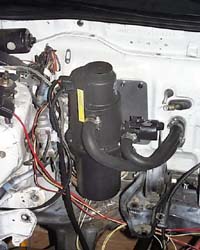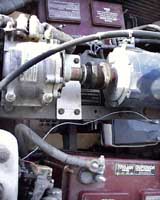The Heating
Manufacturer: MES-DEA
Cost $380
 As far as the
climate control goes, an EV should not be any different from its ICE counterpart.
Naturally, all the controls preferably should work the same way and used for the same
purpose. You sure can wire it any way you wish, but having trunk open when A/C button is
pressed or use speedometer movement to display the battery current, perhaps, is not a
greatest idea. By the same talking when I design my heating system, I wanted to use
components intended for the job. No, I'm a clever engineer too, and like to recycle
components by using them for not intended and sometimes unexpected purpose. A hair dryer
as the cabin heater, or an audio amp fed with sine wave as small AC inverters are quite
common; how about graphite pencils as resistors, and fish line as fiber optic
elements? However, after years of practical experience with all that, I can tell you that
if a decent company designs a product specifically for your application, unlikely you can
beat reliability and convenience of using just that. Even if it cost more initially, I
learned to value my time more than a while ago when I was willing to fix any hobby quality
gadget just because I can and it's cheap. The heater is the perfect example.
As far as the
climate control goes, an EV should not be any different from its ICE counterpart.
Naturally, all the controls preferably should work the same way and used for the same
purpose. You sure can wire it any way you wish, but having trunk open when A/C button is
pressed or use speedometer movement to display the battery current, perhaps, is not a
greatest idea. By the same talking when I design my heating system, I wanted to use
components intended for the job. No, I'm a clever engineer too, and like to recycle
components by using them for not intended and sometimes unexpected purpose. A hair dryer
as the cabin heater, or an audio amp fed with sine wave as small AC inverters are quite
common; how about graphite pencils as resistors, and fish line as fiber optic
elements? However, after years of practical experience with all that, I can tell you that
if a decent company designs a product specifically for your application, unlikely you can
beat reliability and convenience of using just that. Even if it cost more initially, I
learned to value my time more than a while ago when I was willing to fix any hobby quality
gadget just because I can and it's cheap. The heater is the perfect example.
My goal was to have the cabin heated just like stock system
would, make it reliable and safe, easy to install and control and preferably not to tear
the dash apart for installation and maintenance. So, what would be the best solution for
heating an EV? Surprise: an EV heater! Many people use a fan blowing through a ceramic
heating elements, but that solution did not appeal to me because a) exposed hot
nichrome wire, even out of direct reach, is not my idea of safe equipment, and b)
required to modify existing heater core under crowded CRX dash. Perhaps, I'd use that if
no other option would be available, but there was: a Swiss made RM-4 EV heater made by
DES-MEA. This unit is rated at 2 kW, works with 200VDC...450VDC input voltage range, and
consists of the water tank (miniature version of a home electric water heater) with
heating element, water pump and PIC processor based contactless controller integrated in
it. Controller takes care of maintaining preset temperature of 90'C regardless of the
input voltage swings typical for an EV, as well as self-testing, interlocking and
performing necessary safety checks. Application is very easy - all you have to do is plumb
inlet and outlet to the existing heater core, connect the power wires directly across the
propulsion pack, a switch to supplied control harness and pour the water in it. That's it.
The heater functions identical to ICE system - hot water circulating through existing
heater core, and you retain all the control for fan speed i.e. amount of heat in the
cabin.
 The RM-4 EV heater as comes from the factory - side view.
The RM-4 EV heater as comes from the factory - side view.
 Top view
Top view
 Heater rating label
Heater rating label
 Auxiliary water pump rating label
Auxiliary water pump rating label
 The aluminum bracket...
The aluminum bracket...
 ...mounted on the fire wall near the heater core fittings.
...mounted on the fire wall near the heater core fittings.
 Installed and plumbed heater.
Installed and plumbed heater.
 Installed and plumbed heater - side view.
Installed and plumbed heater - side view.
This is it.
Boring.
The Air conditioning
 The air conditioning is not implemented yet, but
all necessary components are retained. Stock CRX A/C radiator (still in the car) and stock A/C compressor will be
used. On this photo my previous implementation is shown. It worked fine, compressor was
driven by Leeson 1.5 hp 180VDC 6.7A PM DC motor via spider type coupling. In my current
project intention is to use small 3 phase AC motor rated at about 380 VAC and fixed
frequency 3 phase solid state inverter. The shaft of the compressor will be modified
(shortened) and the motor-compressor combo physically will be one compact unit. No longer
high priority part (I live up North now), so may not be implemented this year. But
eventually it will.
The air conditioning is not implemented yet, but
all necessary components are retained. Stock CRX A/C radiator (still in the car) and stock A/C compressor will be
used. On this photo my previous implementation is shown. It worked fine, compressor was
driven by Leeson 1.5 hp 180VDC 6.7A PM DC motor via spider type coupling. In my current
project intention is to use small 3 phase AC motor rated at about 380 VAC and fixed
frequency 3 phase solid state inverter. The shaft of the compressor will be modified
(shortened) and the motor-compressor combo physically will be one compact unit. No longer
high priority part (I live up North now), so may not be implemented this year. But
eventually it will.
 Old conversion installation - PMDC motor linked to
the stock A/C compressor
Old conversion installation - PMDC motor linked to
the stock A/C compressor
 Old conversion installation - under hood view. PMDC motor takes quite a bit of space.
Old conversion installation - under hood view. PMDC motor takes quite a bit of space.

 As far as the
climate control goes, an EV should not be any different from its ICE counterpart.
Naturally, all the controls preferably should work the same way and used for the same
purpose. You sure can wire it any way you wish, but having trunk open when A/C button is
pressed or use speedometer movement to display the battery current, perhaps, is not a
greatest idea. By the same talking when I design my heating system, I wanted to use
components intended for the job. No, I'm a clever engineer too, and like to recycle
components by using them for not intended and sometimes unexpected purpose. A hair dryer
as the cabin heater, or an audio amp fed with sine wave as small AC inverters are quite
common; how about graphite pencils as resistors, and fish line as fiber optic
elements? However, after years of practical experience with all that, I can tell you that
if a decent company designs a product specifically for your application, unlikely you can
beat reliability and convenience of using just that. Even if it cost more initially, I
learned to value my time more than a while ago when I was willing to fix any hobby quality
gadget just because I can and it's cheap. The heater is the perfect example.
As far as the
climate control goes, an EV should not be any different from its ICE counterpart.
Naturally, all the controls preferably should work the same way and used for the same
purpose. You sure can wire it any way you wish, but having trunk open when A/C button is
pressed or use speedometer movement to display the battery current, perhaps, is not a
greatest idea. By the same talking when I design my heating system, I wanted to use
components intended for the job. No, I'm a clever engineer too, and like to recycle
components by using them for not intended and sometimes unexpected purpose. A hair dryer
as the cabin heater, or an audio amp fed with sine wave as small AC inverters are quite
common; how about graphite pencils as resistors, and fish line as fiber optic
elements? However, after years of practical experience with all that, I can tell you that
if a decent company designs a product specifically for your application, unlikely you can
beat reliability and convenience of using just that. Even if it cost more initially, I
learned to value my time more than a while ago when I was willing to fix any hobby quality
gadget just because I can and it's cheap. The heater is the perfect example. The air conditioning is not implemented yet, but
all necessary components are retained. Stock CRX A/C radiator (still in the car) and stock A/C compressor will be
used. On this photo my previous implementation is shown. It worked fine, compressor was
driven by Leeson 1.5 hp 180VDC 6.7A PM DC motor via spider type coupling. In my current
project intention is to use small 3 phase AC motor rated at about 380 VAC and fixed
frequency 3 phase solid state inverter. The shaft of the compressor will be modified
(shortened) and the motor-compressor combo physically will be one compact unit. No longer
high priority part (I live up North now), so may not be implemented this year. But
eventually it will.
The air conditioning is not implemented yet, but
all necessary components are retained. Stock CRX A/C radiator (still in the car) and stock A/C compressor will be
used. On this photo my previous implementation is shown. It worked fine, compressor was
driven by Leeson 1.5 hp 180VDC 6.7A PM DC motor via spider type coupling. In my current
project intention is to use small 3 phase AC motor rated at about 380 VAC and fixed
frequency 3 phase solid state inverter. The shaft of the compressor will be modified
(shortened) and the motor-compressor combo physically will be one compact unit. No longer
high priority part (I live up North now), so may not be implemented this year. But
eventually it will.